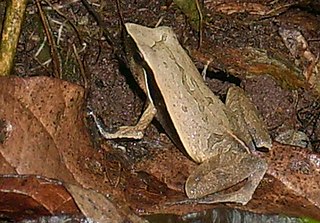
The Anatinae are a subfamily of the family Anatidae. Its surviving members are the dabbling ducks, which feed mainly at the surface rather than by diving. The other members of the Anatinae are the extinct moa-nalo, a young but highly apomorphic lineage derived from the dabbling ducks.

Eaton's pintail is a dabbling duck of the genus Anas. It is also known as the southern pintail. The species is restricted to the island groups of Kerguelen and Crozet in the southern Indian Ocean. It resembles a small female northern pintail. It was named after the English explorer and naturalist Alfred Edwin Eaton. It is threatened by introduced species, particularly feral cats, which prey on it, particularly during the post-breeding molt, when it is unable to fly.

Mato Grosso do Sul is one of Brazil's 27 federal units, located in the southern part of the Central-West Region, bordering five Brazilian states: Mato Grosso, Goiás and Minas Gerais (northeast), São Paulo (east) and Paraná (southeast); and two South America countries: Paraguay and Bolivia (west). It is divided into 79 municipalities and covers an area of 357,145.532 square kilometers, which is about the same size as Germany. With a population of 2,839,188 inhabitants in 2021, Mato Grosso do Sul is the 21st most populous state in Brazil.

The Amazon basin is the part of South America drained by the Amazon River and its tributaries. The Amazon drainage basin covers an area of about 7,000,000 km2 (2,700,000 sq mi), or about 35.5 percent of the South American continent. It is located in the countries of Bolivia, Brazil, Colombia, Ecuador, Guyana, Peru, Suriname, and Venezuela, as well as the territory of French Guiana.

The arapaima, pirarucu, or paiche is any large species of bonytongue in the genus Arapaima native to the Amazon and Essequibo basins of South America. Arapaima is the type genus of the subfamily Arapaiminae within the family Osteoglossidae. They are among the world's largest freshwater fish, reaching as much as 3 m (9.8 ft) in length. They are an important food fish. They have declined in the native range due to overfishing and habitat loss. In contrast, arapaima have been introduced to several tropical regions outside the native range, where they are sometimes considered invasive species. In Kerala, India, arapaima escaped from aquaculture ponds after floods in 2018. Its Portuguese name, pirarucu, derives from the Tupi language words pira and urucum, meaning "red fish".

The Pantanal is a natural region encompassing the world's largest tropical wetland area, and the world's largest flooded grasslands. It is located mostly within the Brazilian state of Mato Grosso do Sul, but it extends into Mato Grosso and portions of Bolivia and Paraguay. It sprawls over an area estimated at between 140,000 and 195,000 km2. Various subregional ecosystems exist, each with distinct hydrological, geological and ecological characteristics; up to 12 of them have been defined.

Loricariidae is the largest family of catfish, with 92 genera and just over 680 species. Loricariids originate from freshwater habitats of Costa Rica, Panama, and tropical and subtropical South America. These fish are noted for the bony plates covering their bodies and their suckermouths. Several genera are sold as "plecos", notably the suckermouth catfish, Hypostomus plecostomus, and are popular as aquarium fish.

The Brazilian teal or Brazilian duck is the only duck in the genus Amazonetta. It is widely distributed in eastern South America.

The Emas National Park is a national park and a UNESCO World Heritage Site in the states of Goiás and Mato Grosso do Sul in Brazil.

Trichomycterus is a genus of fish in the family Trichomycteridae, the largest genus of its family with over 170 species currently described. This genus is native to freshwater habitats in Central and South America. These fish are generally small, usually about 5 to 15 cm (2–6 in) in standard length, although the largest, T. rivulatus, can reach more than twice this size. Species differ from one another primarily in body proportions, fin ray counts and colouration. Despite their relatively small size, some, such as T. punctulatus, support fisheries and are important in the local cuisine.

Physalaemus albonotatus is a species of frog in the family Leptodactylidae. It is found in Brazil, Paraguay, and Chacoan Argentina and Bolivia.

Serra da Bodoquena National Park is a national park in the state of Mato Grosso do Sul, Brazil.

Cavefish or cave fish is a generic term for fresh and brackish water fish adapted to life in caves and other underground habitats. Related terms are subterranean fish, troglomorphic fish, troglobitic fish, stygobitic fish, phreatic fish, and hypogean fish.

Girardia is a genus of freshwater planarians belonging to the family Dugesiidae.
Girardia tigrina, known as the brown planarian or the immigrant triclad flatworm, is a species of dugesiid native to the Americas. It has been accidentally introduced into Europe and Japan.
Girardia dorotocephala is a species of dugesiid triclad native to North America. It has been accidentally introduced in Japan. Girardia dorotocephala is cannibalistic, which led to its usage in memory transfer experiments.

Hausera is a subterranean genus of planarian from Brazil. It contains only the single species Hausera hauseri. It is the first cave-dwelling member of the suborder Cavernicola to have been observed in South America.

Hadopyrgus ngataana is a tiny, transparent, and critically endangered freshwater snail, found only in a single stream in a cave in New Zealand.
Brasiliochoerus stenocephalus is an extinct species of peccary that lived in South America during the Late Pleistocene. Fossils have been found in Brazil, Argentina and Bolivia. It is commonly known as the narrow-headed peccary due to its long and markedly convex rostrum.
Paraba aurantia is a species of land planarian belonging to the subfamily Geoplaninae. It is found within Brazil.
















